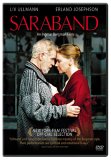A sequel to Ingmar Bergman’s 1973 classic Scenes from a Marriage, Saraband reintroduces us to Marianne (Liv Ullman) and Johan (Erland Josephson) after 32 years apart, when Marianne decides it’s time to pay her ex-husband a visit. Upon arrival, she becomes involved in strained family relations between Johan, his son Henrik (Borje Ahlstedt), and Henrik’s daughter Karin (Julia Dufvenius). There are implications that Henrik and daughter share an incestuous relationship, highlighted by a scene where they lie…in bed together, and another where they share an open-mouthed kiss. This tension and madness is complicated by the death of Anna, Karin’s mother and Henrik’s wife, who had been the functioning glue holding them together and preventing the likelihood of a three-way steel cage death match. With her out of the picture, these three are allowed to let their dysfunctional lights shine. Marianne – for whatever reason, perhaps an unknown feeling of obligation to Anna – gets involved in the proceedings, but soon finds out that people will die the way they live, and there is just no getting through to anyone in the long-term – especially in the moments of their lives depicted here. “Too set in their ways,” is understatement with regards to Johan, Henrik, and Karin. And as is often the case when a well-liked loved one dies, Anna’s absence brings out the worst in everyone.
While film is a visual medium, Saraband does not treat it as such. Its problem has nothing to do with incompetence from Bergman’s direction, nor does it involve inadequate performances from the actors. The central issue at hand is the script’s poor use of dialogue. The words are well-written, but their overall function goes against what film is designed to be, and are better suited for the stage than the screen. I would venture a guess there are more words of speech in this film’s two-hour running time than in a novelist’s entire manuscript. Accompanying the wordiness is the urge for exposition. I understand budget restraints may have prevented the film from showing all it wants to show, but that still doesn’t make the extensive expository dialogue interesting. While this film could be a fantastic play, as a movie, it’s a sluggish viewing experience. Still, I do get the feeling from Bergman this is a deep, personal film, which was made for his own benefit rather than the pleasure of any audience. As such, it succeeds in tackling the issues and emotions Bergman feels at this point in his life, as he draws the curtain on a long, glorious career. But that also illuminates what is, perhaps, the film’s greatest weakness – it’s simply too personal to be interesting.
Video
The 1.78:1 anamorphic widescreen presentation provides a clean frame through which to view the picture. Contrast is also present in impressive form, but it’s the use of color that stands out most of all. One particular scene which comes to mind as an example is Karin’s flashback of her fight with Henrik over his teaching methods. She criticizes him and storms for the deep red door, only to be caught and taken to the ground. Bergman fills the frame with a close-up of this door and leaves a disturbing window of opportunity for our imagination to conjure up vile images of what is going on out-of-frame. Whether what we think is happening really is or not, Bergman then adds to our worries by cutting to a scene of Karin running through the woods. She appears disheveled and shaken beyond the point of normalcy, and we can’t help but wonder if our worst suspicions of what happened are true. It is to Bergman’s credit that he can still use the camera in such a mesmerizing way, even as his characters ramble on far past the point of what is deemed interesting. It has been said that Bergman’s major set-pieces are his actors, and this is nowhere more apparent than it is here – but he still makes the most of his settings, despite their stage-like sparseness.
Audio
The Dolby Digital 2.0 Swedish track provides strong dialogue and an overall high volume. Bass doesn’t have much business in the film, and as such, remains largely absent. However, the track manages to isolate its needs and execute with the utmost strength. Still, one can’t help but feel that a monaural track would have worked just as well.
Special Features
The only bonus material to speak of is a making-of featurette, which goes well beyond the expected status of glorified advertisement. In it, we get a real taste of what drives Bergman, as well as his methods for working. We are also given some insight into the comfort and familiarity his cast and crew have with him, despite his high expectations. The 84 years have not softened his style, and it shows in the featurette. Rounding out the package, there are some trailers for three unrelated films.
Final Thoughts
The artistry and craftsmanship of a strong filmmaker are as present as they ever were in the body of Ingmar Bergman. Still, it’s the oversight of a visual script and perhaps the added restraints of a small budget that limit the potential of Saraband. I would still recommend it to viewers interested in the rest of Bergman’s body of work. Or even more to those fascinated by the man himself, as the work is largely autobiographical – if not from a physical perspective, then definitely from an emotional one. And I do applaud the film’s unflinching honesty. It has a lot to say, and it doesn’t stop till it has addressed each issue. However, in doing so, Bergman’s swan song creates an overly wordy piece heavy on exposition and light on intrigue.
Special Features List
- The Making of SARABAND
- Previews





